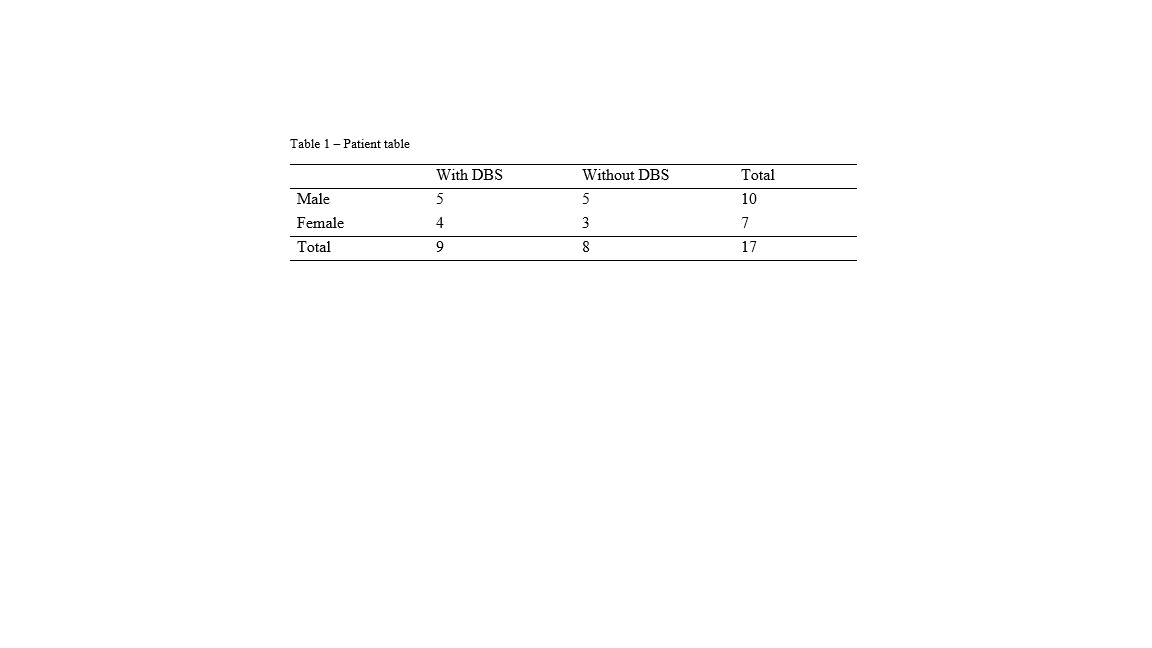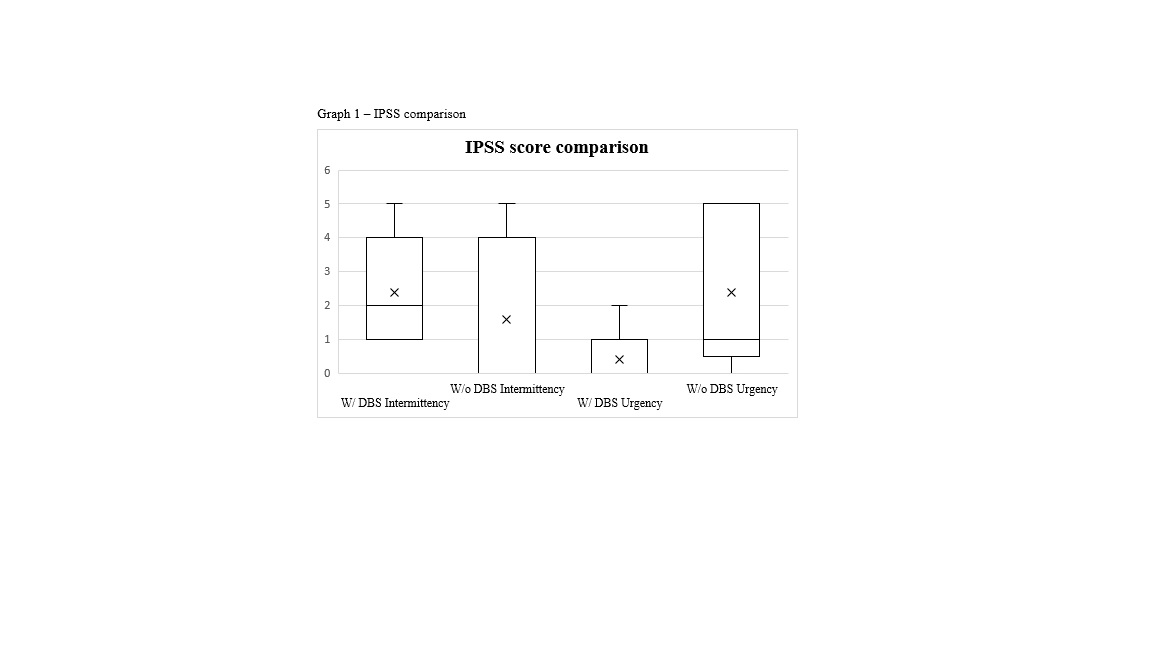Category: Parkinson's Disease: Non-Motor Symptoms
Objective: To evaluate lower urinary tract symptoms between Parkinson’s Disease (PD) patients with and without deep brain stimulation (DBS).
Background: Parkinson’s disease (PD) is well known for causing motor1 and non-motor symptoms². Lower urinary tract symptoms (LUTS) are extremely common in patients with PD and can be irritative, obstructive or mixed; being irritative the most common in PD3.
We present the preliminary results of an ongoing study about LUTS in PD patients, utilizing specific gender scores for each sample. For the male patients it was used IPSS (International Prostate Symptom Score) and for female patients, the ICIQ OAB (International Consultation on Incontinence Questionnaire Overactive Bladder).
Method: We conduct a retrospective cohort study in 17 PD patients, 9 with DBS (5 males and 4 females) 8 without DBS (5 males and 3 females). Disease duration ranging between 5 and 12 years of PD and with optimized oral treatment (table 1). All patients had DBS proposed, however the surgery was not performed in 9 of them due to COVID-19 restrictions. This group was used as control group. We used the IPSS for male patients and ICIQ OAB for females.
Results: The male participants of the study presented similar average between groups. The DBS group had 14,2±10,2 points, and the control group 13,2±5,4 points (p=0.81), which demonstrate no statistical significance. The obstructive symptoms (like intermittence) had similar or worse scores in the DBS group; this may be justified by older average age in this group (61,5 ± 7,2 years) against the 56,25 ± 8,15 years in the control group4. Irritative symptoms (like urgency) demonstrated a tendency to lower values in the DBS group. See graph 1 for comparison between intermittency (p=0,42) and urgency (p=0,15).
We see a similar tendency in the female population: milder symptoms in all sub scores in the DBS group, like urgency (p=0,62), see graph 2 for example.
Conclusion: The most limiting factor is the small sample of this study. We are actually conducting a prospective study with a large population. Despite that, our results confirm the trend of recent studies5,6: DBS tends to present a more significant positive effect in female than male population in PD.
References: 1. SAUERBIER, A. et al. Non motor subtypes and Parkinson’s disease. Parkinsonism and Related Disorders, v. 22, p. S41–S46, 2016.
2. SVEINBJORNSDOTTIR, S. The clinical symptoms of Parkinson’s disease. Journal of Neurochemistry Blackwell Publishing Ltd, , out. 2016.
3. MCDONALD, C.; WINGE, K.; BURN, D. J. Lower urinary tract symptoms in Parkinson’s disease: Prevalence, aetiology and management. Parkinsonism and Related Disorders. Elsevier Ltd, , 1 fev. 2017.
4 WINGE, K.; NIELSEN, K. K. Bladder dysfunction in advanced Parkinson’s disease. Neurourology and Urodynamics, v. 31, n. 8, p. 1279–1283, nov. 2012
5 ZONG, H. et al.
Clinical study of the effects of deep brain stimulation on urinary dysfunctions in patients with Parkinson’s disease
. Clinical Interventions in Aging, v. Volume 14, p. 1159–1166, 2019
6 LIANG, F. et al. Effect of Deep Brain Stimulation on Female Parkinsonian Patients with Lower Urinary Tract Symptoms. Neuropsychiatric Disease and Treatment, v. Volume 17, n. September, p. 3727–3733, 2021
To cite this abstract in AMA style:
P. Araújo, A. Francisco, R. de Fraga, L. Frizon, M. ávila, I. Filho, L. Pancera, G. Schaidt, J. Goginski, A. Farinazzo. THE EFFECT OF DEEP BRAIN STIMULATION ON LOWER URINARY TRACT SYMPTOMS IN PARKINSON’S DISEASE [abstract]. Mov Disord. 2022; 37 (suppl 2). https://www.mdsabstracts.org/abstract/the-effect-of-deep-brain-stimulation-on-lower-urinary-tract-symptoms-in-parkinsons-disease/. Accessed January 4, 2026.« Back to 2022 International Congress
MDS Abstracts - https://www.mdsabstracts.org/abstract/the-effect-of-deep-brain-stimulation-on-lower-urinary-tract-symptoms-in-parkinsons-disease/



